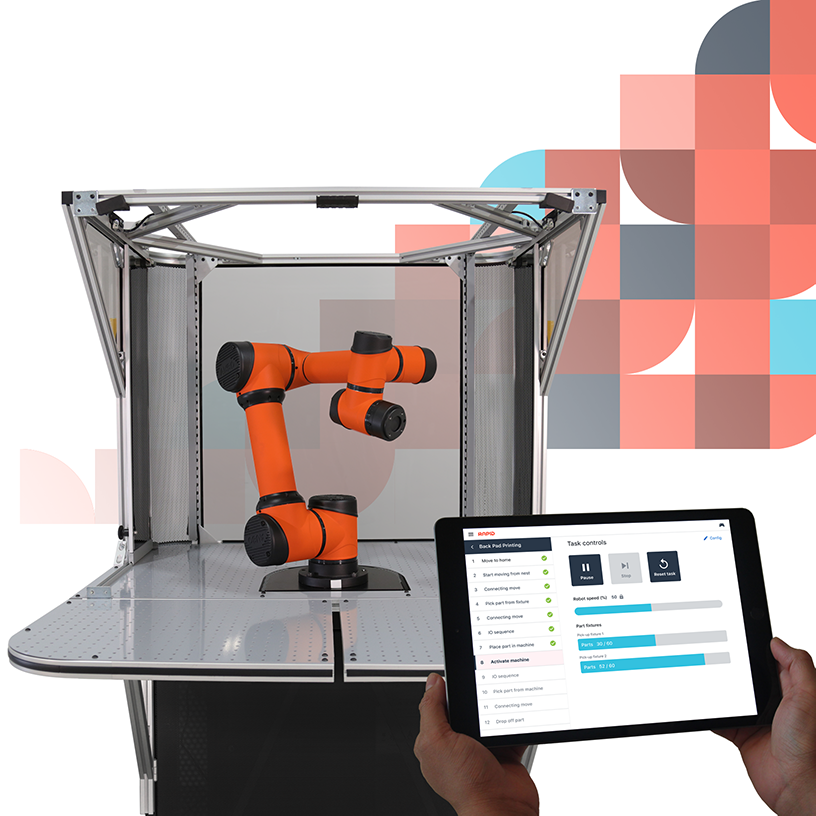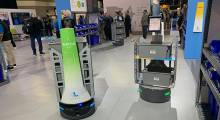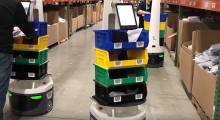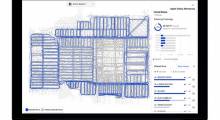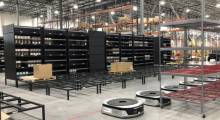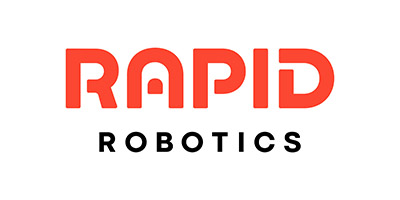Rapid Robotics yesterday announced $12 million in Series A funding led by New Enterprise Associates. The San Francisco-based company claims to have created the “first ready-to-work robotic machine operator designed for simple machine tasks.”
The Rapid Machine Operator is available through a robotics-as-a-service (RaaS) model for $25,000 per year, and it requires no programming, systems integration, specialized hardware, or robotics skills, said Rapid Robotics. This enables manufacturers to easily deploy a pretrained cobot in hours, moving it between tasks as needed and seeing return on investment (ROI) in months, according to the company.
Rapid Robotics aims to address factory shortage
Until recently, manufacturers were caught between a scarcity of machine operators and an inability to automate. Deloitte estimates that by the end of the decade, U.S. manufacturers may have 2.4 million unfilled jobs, putting $454 billion of business at risk.
The shortfall is especially acute among operators who work the machines that perform 80% of all factory tasks. Some estimates predict that U.S. manufacturers could need 600,000 more workers to meet demand and compete with factories overseas.
Rapid Robotics said its entry into the market “comes at a pivotal moment for U.S. manufacturing, as the Biden administration rolls out ambitious plans to revitalize the sector, boosting competitiveness in areas including automotive, pharmaceuticals, public health, and semiconductor.”
“If we don’t solve this problem, U.S. manufacturers will never be able to compete in a global market,” said Jordan Kretchmer, CEO of Rapid Robotics. “It’s really that simple.”
“America’s shortage of machine operators is a bona fide crisis,” said Forest Baskett, general partner at New Enterprise Associates (NEA) and former CEO of Silicon Graphics. “We have to address it if we want to make America a manufacturing leader again.”
The Rapid Machine Operator (RMO) can perform common tasks such as injection molding, pad printing, heat stamping, and pick-and-place operations, said Ready Robotics. Unlike other robots, RMO comes with with machine vision and pretrained artificial intelligence so it can get to work in less than a day, it claimed. In addition, the company said an entire RMO fleet can share expertise and new skills through the cloud, gaining capabilities over time.
Each RMO is controlled via tablet, so no robotics expertise required, and it can be easily repurposed for new tasks as the need arises using 3D-printed grippers that can be quickly fabricated on site for no additional charge, Ready Robotics said.
Demand for Rapid Machine Operator
“Robotics made sense for large-scale assembly-line jobs with decades-long windows for ROI, but not for operating the manufacturing machines,” Baskett said. “Robots cost too much to begin with and even more to train. The numbers just didn’t pencil out.”

Rapid Robotics claimed to have changed this “automation equation” with Rapid Machine Operator, and now its biggest problem is keeping up with demand.
“I’ve been in manufacturing for more than 20 years, and the enthusiasm for the Rapid Machine Operator is like nothing I’ve ever seen,” said Mike Lewis, head of sales and marketing at Rapid Robotics and former vice president of business development at Flex, a global technology, supply chain, and manufacturing company.
“When we meet with potential customers, at first, they’re skeptical because they’ve been burned by vendors who couldn’t deliver,” he said. “When they see what the Rapid Machine Operator can do, they start to get excited. By the end of the visit, they just want to know how soon we can get RMOs in place.”
Investing in affordability
In addition to NEA, participants in Rapid Robotics' Series A include NEA, Greycroft, Bee Partners, and 468 Capital. The company raised $5.5 million in seed funding in November 2020.The latest investment brings the Rapid's total funding to $17.5 million.
Rapid Robotics said its systems have produced more than 50 million parts over the past year across almost every industry sector including plastics, metals, medical devices, automotive, pharma, semiconductors, and electronics.
With Rapid Machine Operators available by subscription for less than $2,100 per month, manufacturers can increase profits by an average of $110,000 per year for each unit installed, said Rapid Robotics. The RaaS model, which is similar to software as a service and transfers costs from capital expenditures to operational expenditures, enables manufacturers to bid for work that previously would have gone overseas, it noted.
“It’s hard to overstate the economic implications of the Rapid Machine Operator,” said Aaron Jacobson, partner at NEA. “After looking at numerous robotics startups in America and beyond, only Rapid Robotics had the right technology focused on the right needs to make a broad-based, immediate impact on the competitiveness of U.S. companies.”
RMO customers
Rapid Robotics' customers said the Rapid Machine Operators have not only helped them win contracts, but also helped increase headcount and transition existing employees to less-repetitive, higher-value, more satisfying work.
Global component fabricator Fabri-Tech is using the robots for package heat-sealing in its Fremont, Calif., facility. Applied Engineering, a contract manufacturing company in South San Jose, Calif., is applying labels to pharmaceutical vials with RMOs.
Hayward, Calif.-based TouchMark is using Rapid Machine Operators for pad-printing plastic components for medical devices and semiconductors.
“We process many parts and have to expedite jobs frequently for our customers but were struggling to keep adequately staffed to meet the demand,” said Ryan Gagne, engineering manager at TouchMark. “The highly precise process requires three human operators each day, which limited our ability to meet the customer’s needs and to take on new work.”
“When we brought in Rapid's RMOs, we were able to upskill those employees to execute other more complex tasks and to oversee the new robotic workforce,” Gagne said. “Using Rapid Machine Operators on these simple tasks has also increased our capacity and reduced lead times for our customers.”
“The Rapid Machine Operator flips the typical automation narrative on its head,” said Kretchmer. “It doesn’t just increase productivity; it boosts employment. By bringing manufacturing work back onshore, Rapid Machine Operators are actually helping businesses create jobs for American workers.”
Article topics
Email Sign Up

